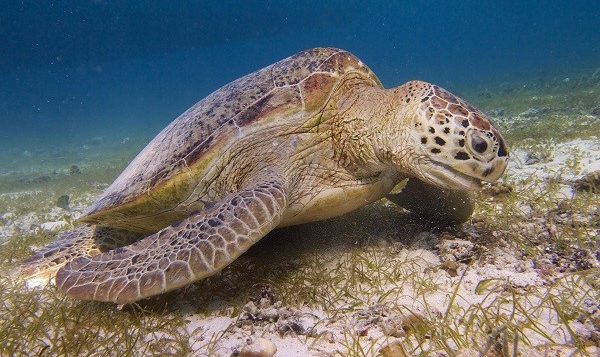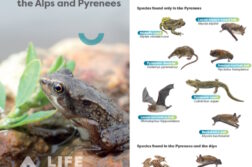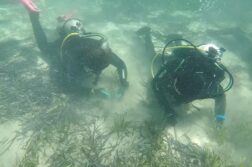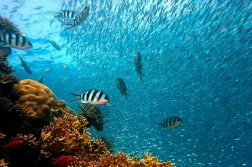Conservation efforts in recent decades have facilitated a remarkable recovery of some green turtle populations at different points in tropical seas around the world. However, in these places, the excessive grazing caused by these chelonians is threatening the grasses of marine plants and could generate underwater ‘deserts’, according to an article published in the journal Nature Ecology & Evolution in which the researcher Jordi Pagès, of the Faculty of Biology and the Biodiversity Research Institute of the University of Barcelona (IRBio), and also a member of the Center for Advanced Studies of Blanes (CEAB-CSIC) has participated.
The voraciousness with which large aggregates of green turtle (Chelonia mydas) – an eminently herbivorous species with a global distribution in tropical and subtropical waters – act would require a review of current conservation and management models of marine plant grasses to avoid a process of progressive ‘overgrazing’. The work is led by researchers Marjolijn Christianen, from Wageningen University, and Marieke van Katwijk, from Radboud University (Netherlands), and also involves researcher Teresa Alcoverro (CEAB-CSIC).
From the savannah to the underwater forest: new perspectives in ecology
Underwater meadows are made up of species of marine phanerogams that generate a habitat of great ecological value (food, shelter, reproduction, coastal protection, etc.) which is key to conserving marine biodiversity. In these complex ecosystems, sea turtles feed and generate a dynamic mosaic landscape with leafy areas and patches that reveal different stages of grazing.
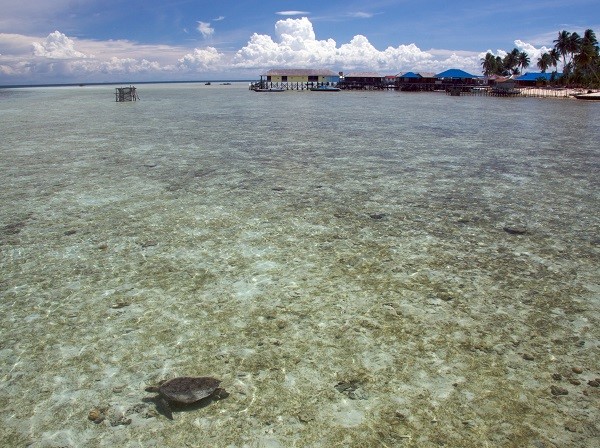
The article argues that large pre-Anthropocene marine grasses would have been heavily grazed by large marine herbivores such as green turtles, so that these habitats would look more like a ‘savannah’ than a ‘submarine forest’. The work also emphasizes the misconception of considering forests as ‘virgin’ systems and savannas as ‘degraded’ systems. Thus, a marine forest formed by dense, undulating prairies full of long-leaved phanerogams would be no more natural than a landscape of areas with dense vegetation interspersed with patches grazed by sea turtles.
“On land, the idea that a savannah is a ‘degraded state’ of a forest has long been abandoned, in order to highlight the fact that some ecosystems – such as savannahs – have to naturally more pressure from herbivores or fires “, explains Jordi Pagès, who is a Marie Sklodowska-Curie researcher in the Ecology Section of the Department of Evolutionary Biology, Ecology and Environmental Sciences at the UB. “In the marine environment, pre-Anthropocene underwater meadows were probably less leafy and more heterogeneous than we thought. This particularity is not negative in itself but it would involve certain environmental costs in the form of loss of ecosystem services.
“However, what must be avoided is excessive overgrazing that causes the disappearance of seaweeds as the process of recovery and restoration of marine plant habitats is, in general, very unsuccessful. If this point is reached, the loss of services provided by marine plants is irreparable,” warns the researcher.
“Marine grasslands are changing due to grazing, but if grazing continues for too long, seagrass meadows become extremely vulnerable and even a very small storm could wipe them out, says researcher Marieke van Katwijk.
Avoid the disappearance of marine grasslands
This new perspective proposed by the research team would require a change in the perspective of environmental management in these marine areas.
“There is a potential conflict between the effort to conserve a marine ecosystem that generates optimal ecosystem services for humans – coastal protection, food production, etc. – and the conservation and recovery of populations of such charismatic animals. such as sea turtles, ”says researcher Marjolijn Christianen.
To solve the dilemma, the team proposes to accept the partial loss of ecosystem services of large marine grasslands without ever reaching a total disappearance or loss.
“It should be remembered that despite the conservation success of the large populations of green turtles found in some parts of the world, turtle populations continue to be under a lot of pressure on a global scale. As the successes multiply, it may be necessary to accept that the grasses of marine plants with megaherbivores will be less leafy and more heterogeneous than the grasses where the populations of megaherbivores have disappeared “, concludes Teresa Alcoverro (CEAB-CSIC).
Reference article:
Christianen, M.J.A., van Katwijk, M.M., van Tussenbroek, B.I. et al. A dynamic view of seagrass meadows in the wake of successful green turtle conservation. Nat Ecol Evol (2021). https://doi.org/10.1038/s41559-021-01433-z


